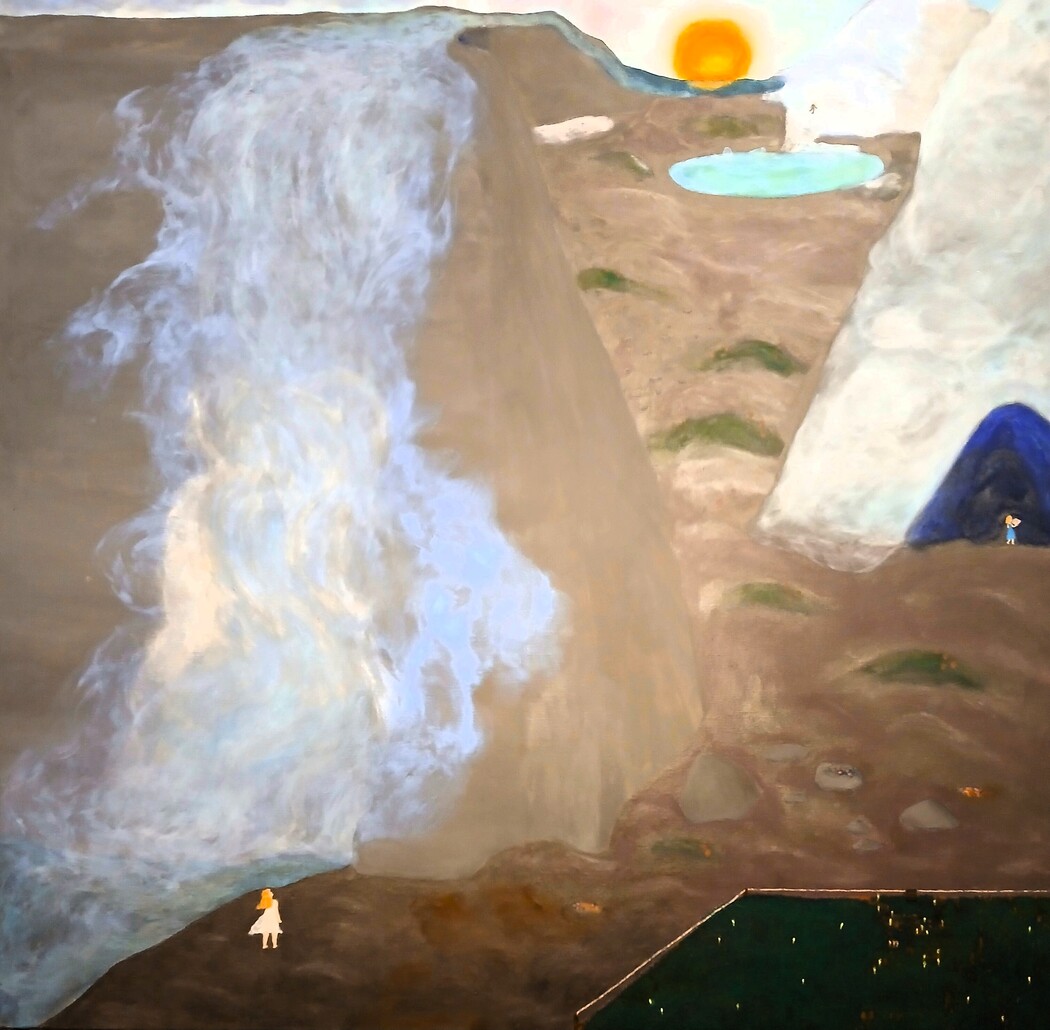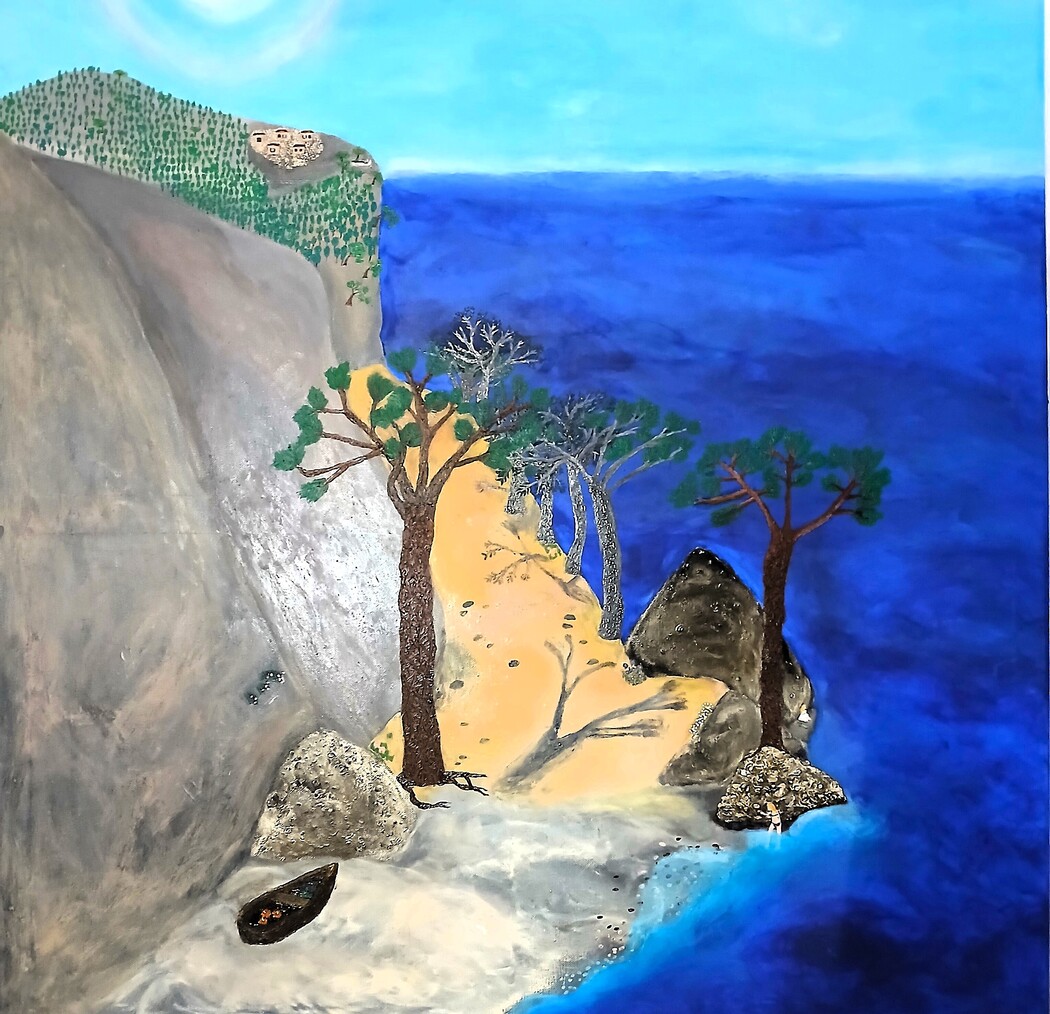Prudence Audié
Year of birth: 1996
Where do you live: I live and work mostly in Paris. I also work in the Ligurian Apennines, where I have a studio.
Your education: After studying Latin and Ancient Greek, I turned to philosophy and art history at the Ecole Normale Supérieure de Paris, building up my visual arts practice at the Sorbonne. My philosophical research initially focused on the transposition of the concept into images and gestures in the reception of Nietzschean thought by contemporary artists. I then focused on pre-Socratic philosophy. I am currently doing a PhD on the thought of Empedocles and its Nietzschean interpretation.
Describe your art in three words: reflexive, marvelled, archaic
Website

Your background in philosophy and plastic arts is unique. How does this interdisciplinary foundation shape your artistic process?
The guiding problem of my artistic and philosophical work is the same. It’s about knowing whether our relationship with nature today can still be meaningful, whether nature without divine or metaphysical transcendence can make sense to us. Is a solitary encounter with nature still possible? Or is the only thing to be found in solitude nothingness?
Combining my artistic and philosophical studies has enabled me to reflect constantly on the relationship between concepts and images. Painting has given me just the right distance from the sensitive experience of nature that is at the root of my questioning: it can express this experience through direct, immediate perception, but it also seeks to understand it by exploring various links between concepts and points of view through the characters it depicts.
Your work often explores the relationship between humanity and nature. How do you personally define this relationship, and how has it evolved through your art?
I search the world over for places where nature reveals itself in all its materiality. For me, a journey is a moment of recollection. The starting point for each painting is the sensitive experience of a place, the experience of what I call ‘the elemental’: a space where some of the multiple forms of expression of the ‘elements’ fire, air, water and earth are expressed, and where our kinship with the elemental can be felt directly. The elemental then appears as the foundation of the living, circulating through the organic and the inorganic. For me, nature is neither an object of study available to us, nor a transcendent ideal, nor the reflection of a the human soul. I would like to think about nature from the elemental point of view, by placing human beings back among the living creatures.
The relationship with nature in its elemental dimension is approached from the feminine point of view, both in my paintings and in my poetic work. I try to understand the place of the human being within the living world, but also the place of women. In my stories and paintings, I imagine female characters who withdraw from the social world. I want to show that women can exist outside the realm of desire. These women also often have childlike features. I don’t want to show the disproportion of nature in the face of humans, but the difficulty of choosing an isolated lifestyle for a woman, by expressing a certain feeling of vulnerability.
 Prudence Audie, Experience of the Elemental (Punta Chiappa), 2024
Prudence Audie, Experience of the Elemental (Punta Chiappa), 2024
In your project statement, you question the role of myth and the sacred in our perception of nature. Can you elaborate on how these concepts influence your paintings?
On the one hand, mythological divinities are projections of the human point of view on nature. This gives the elements a human face, as in the painting representing Mount Etna, ‘The Divine or the Elemental’. On the other hand, my artistic work seeks to represent the elemental as a form of living being that obeys a different temporality and measure, but that circulates through us, that attracts the figure and imposes itself on him. For me, this reflection on this alterity that constitutes us is a way of thinking about the divine without introducing transcendence.
Your pieces seem to evoke a dialogue between the elemental and the human. What do you hope viewers will feel or reflect upon when experiencing your work?
I’d like to share this sensitive experience of the ‘elemental’ by encouraging viewers to see nature in a different way, in all its materiality: I’d like them to become attentive to detail, to marvel at all the ways in which the ‘elements’ express themselves, and to discover in them another form of life.
 Prudence Audie, Experience of the Elemental (Skogafoss), 2023
Prudence Audie, Experience of the Elemental (Skogafoss), 2023
Your PhD research on the Pre-Socratic philosophy of Empedocles focuses on nature. How has this research directly impacted the themes and style of your paintings?
My research work allows me to question the notions that shape my relationship with nature: the living, the human, the elemental. I became interested in the thought of Empedocles because there is a double dimension to the materiality of nature: the ‘elements’ have a material face and a divine face. The mythological deities express the multiple forms of the elements. This tension in Empedocles’ poem corresponds to the problem that concerns me in my artistic and poetic work.
Your poetry and painting are deeply connected. Could you share more about how your poetic writings inspire or complement your visual art?
Each painting is a representation of this experience of the ‘elemental’ in nature: it captures and analyses this experience. The painting is the choice of a place whose sensitive characteristics – the light, the colours, the type of vegetation, the rocks, the spatial configuration, etc. – reveal the presence of the elemental in nature, as well as the connections between beings, the continuity between the organic and the mineral. The poetic writing seeks to define these notions, to identify the concepts that enable us to analyse and understand this experience of the ‘elemental’. Each canvas is therefore also an articulation of concepts.
Description plays an important role in my poetic work: I write with the place I might be painting in front of my eyes. By this I don’t mean that I’m trying to give an ‘aestheticised’ vision of nature. Rather, through writing as through painting, I want to encourage people to perceive nature differently, in other words, to be attentive to the details and sensitive appearances through which the ‘elemental’ manifests itself.
Writing poetry has also enabled me to attach particular importance to the point of view on the canvas. I like to multiply the perspectives in my texts. Each canvas depicts one or more characters who may have different attitudes to nature. In the painting ‘Experience of the Elemental Skogafoss’, for example, there is a character in the ice cave trying to classify what she sees in a notebook, a character climbing a glacier with equipment and the character in the foreground splashed by the waterfall. These three different attitudes to nature should make it possible to clarify the concept of the ‘elemental’: it should not be sought after but should surprise us, imposing itself on us in an immediate sensitive experience.
 Prudence Audie, Spring or The Right Distance, 2024
Prudence Audie, Spring or The Right Distance, 2024
In an era where nature is seen as a ressource, your work invites us to see it differently. What role do you believe art plays in reshaping societal perceptions of nature?
Painting is a long and solitary process. For me, it’s a way of celebrating nature: choosing this retreat from the world to paint a place that deserves our time. The paintings often show people concentrating on their work, whether they are sculpting, cooking, angling or drawing, and yet they enter into correspondence by sharing the space of the painting. In this way, I want to show that painting creates invisible links not only between living beings, by showing the dialogue between the organic, the mineral and the elemental, but also between people through the sharing of this experience.
 Prudence Audie, Thambos (Sacred Stupor), 2022
Prudence Audie, Thambos (Sacred Stupor), 2022

Leave a Reply